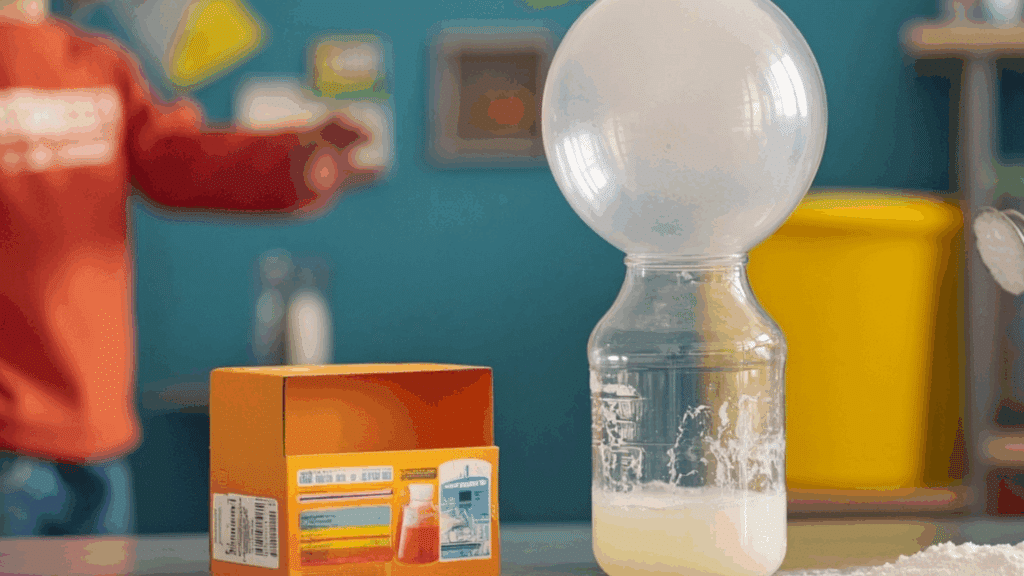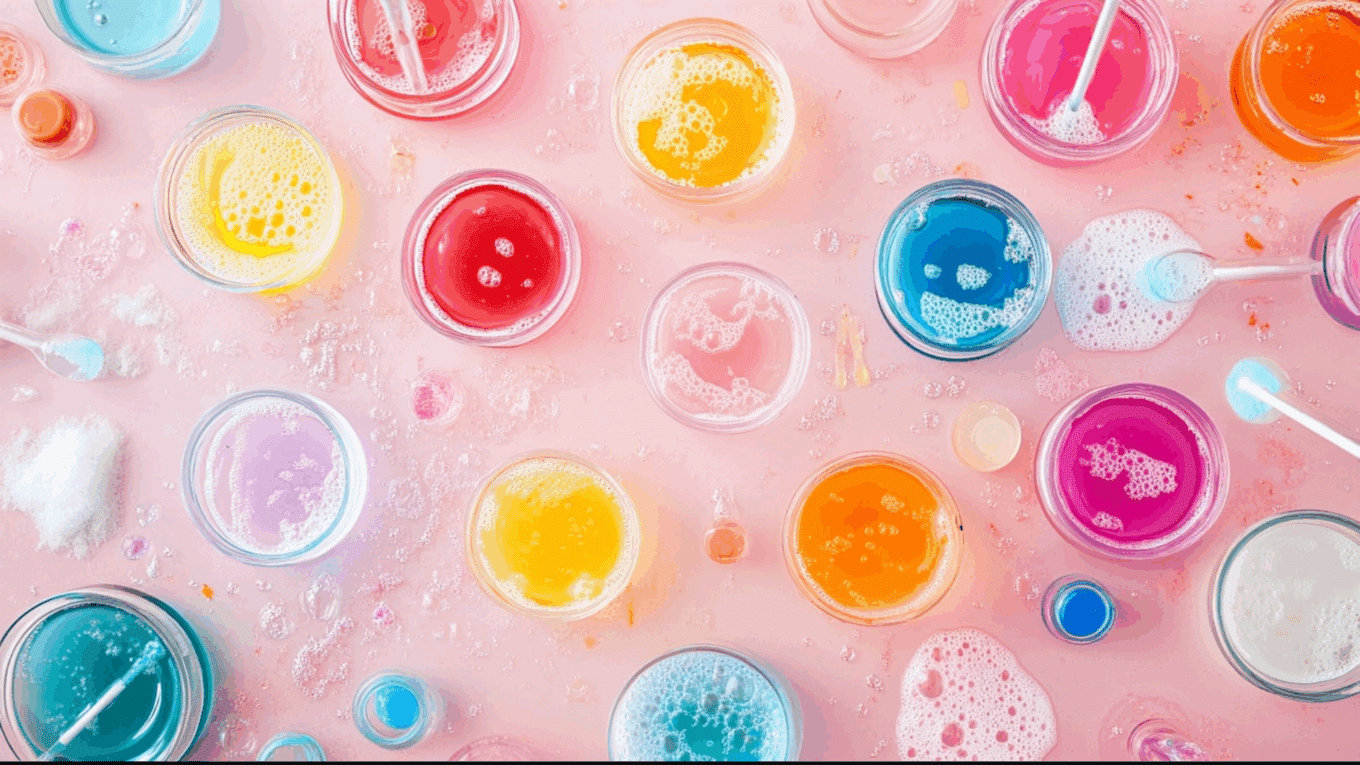Parents often struggle to find fun activities that keep kids busy while teaching them something useful. Science experiments seem complicated and messy, but they don’t have to be.
These simple baking soda and vinegar experiment will turn any kitchen into a learning lab.
Kids love watching the fizzy reactions, and parents love how easy these activities are to set up.
This blog shows five safe experiments using items already in most homes. Each experiment takes less than 10 minutes to prepare and offers hands-on learning that kids remember.
Is Baking Soda and Vinegar Experiment Great for Kids?
Yes, these experiments work so well because they’re safe, cheap, and create instant results. Kids see the bubbling action right away, which keeps them interested.
Most homes already have both ingredients, so parents don’t need to buy special supplies. The reactions are mild enough for young children but exciting enough to hold their attention.
Plus, cleanup is simple since both ingredients are non-toxic.
Key benefits:
- Safe ingredients found in most kitchens
- Quick reactions that grab kids’ attention
- Low cost – no expensive materials needed
- Easy cleanup with just soap and water
- Teaches basic science through hands-on fun
Fun and Safe Baking Soda and Vinegar Experiment

Each baking soda and vinegar experiment is safe for kids and creates instant results that hold their attention. The basic reaction works the same way every time, making it perfect for repeated fun and learning.
1. Classic Volcano Eruption
Make your own erupting volcano using everyday items.When baking soda and vinegar mix, they create carbon dioxide gas, causing a bubbly explosion that looks like lava.
Add dish soap for extra foam and food coloring for fun effects. It’s a simple way to learn chemistry while crafting a cool structure.
Science Principle: Chemical reaction (acid-base reaction creates gas)
Materials: Baking soda, vinegar, cup, dish soap, food coloring, modeling clay
Steps:
- Shape volcano with cup inside
- Add baking soda
- Mix in dish soap and coloring
- Pour in vinegar
- Watch the lava erupt
2. Inflating Balloon Trick
Blow up a balloon without using your breath. This fun science activity shows how a gas can inflate a balloon when vinegar and baking soda react.
The chemical reaction releases carbon dioxide, which fills the balloon with air. It’s a great introduction to gases and chemical change for kids.
Science Principle: Carbon dioxide expansion from chemical reaction
Materials: Balloon, vinegar, baking soda, bottle, funnel
Steps:
- Pour vinegar into bottle
- Use funnel to add baking soda into balloon
- Attach balloon to bottle
- Lift balloon to drop baking soda
- Balloon inflates by itself
3. Color-Changing Potion
Turn a regular science experiment into a magical color show! Using red cabbage juice as a pH indicator, you can change colors as you mix vinegar and baking soda.
The solution changes from purple to pink to blue, depending on its acidity. It’s perfect for teaching about acids and bases.
Science Principle: pH level indicator and acid-base balance
Materials: Red cabbage juice, vinegar, baking soda, cup
Steps:
- Pour cabbage juice into cup
- Add vinegar to turn it pink
- Slowly add baking soda
- Watch it turn blue
- Keep experimenting with more
4. Fizzing Ice Cubes
This cool experiment uses frozen vinegar cubes placed on baking soda. As the ice melts, it fizzes and bubbles, making it a colorful and fun sensory activity.
You can add food coloring to the cubes for an extra visual pop. It’s a playful way to explore states of matter and reactions.
Science Principle: Phase change and chemical reaction
Materials: Vinegar, baking soda, food coloring, ice tray, plate
Steps:
- Mix vinegar and food coloring
- Freeze in an ice tray
- Sprinkle baking soda on plate
- Add ice cubes
- Watch them melt and fizz
5. Rocket Pop-Off
Make your own mini rocket using the fizz from baking soda and vinegar. When gas builds up inside a film canister, pressure increases until the lid pops off and the rocket blasts up.
This experiment is a safe and exciting way to demonstrate propulsion and gas pressure.
Science Principle: Gas pressure buildup and force release
Materials: Film canister, vinegar, baking soda, tissue
Steps:
- Fill canister with vinegar
- Wrap baking soda in tissue
- Drop it in quickly
- Seal the lid fast
- Step back and launch
6. Invisible Ink Reveal
Send secret messages using science. Write with vinegar on paper and let it dry.
When you brush over it with a baking soda and water mix, the message reappears thanks to an acid-base reaction. This activity combines chemistry and mystery, making it both fun and educational for curious minds.
Science Principle: Acid-base indicator reaction
Materials: White paper, cotton swab, vinegar, baking soda solution
Steps:
- Dip swab in vinegar
- Write on paper and let it dry
- Mix baking soda with water
- Brush mixture over the message
- Watch your secret words appear
7. Foaming Hand Soap Surprise
Make your own foamy science fountain. By adding dish soap to the classic baking soda and vinegar combo, the reaction becomes extra frothy.
It’s safe to touch, exciting to watch, and an easy way to explore chemical changes while playing with bubbles. Great for hands-on learners and young scientists.
Science Principle: Gas release and soap-enhanced foam
Materials: Baking soda, vinegar, dish soap, cup
Steps:
- Pour baking soda into cup
- Add a squirt of dish soap
- Stir gently for mixing
- Slowly add vinegar
- Enjoy the fizzy foam overflow.
8. Lava Lamp in a Glass
Create your own fizzy lava lamp without any heat. This experiment uses baking soda, oil, and vinegar to make colored bubbles float and fall.
The carbon dioxide from the reaction lifts the colored water through the oil. It’s a fantastic way to learn about density and chemical reactions.
Science Principle: Density and gas lift from chemical reaction
Materials: Baking soda, vinegar, oil, food coloring, clear glass
Steps:
- Add baking soda to the glass
- Pour in oil, then water
- Add food coloring
- Slowly pour vinegar
- Watch colored blobs rise and fall.
9. Bubbling Treasure Rocks
Hide small treasures inside baking soda rocks that bubble away when vinegar touches them. As the fizz breaks down the rock, the surprise toy is revealed.
This is a fun way to combine sensory play and chemistry, especially for treasure hunts or party games.
Science Principle: Dissolution and acid-base fizz
Materials: Baking soda, water, food coloring, small toy, vinegar
Steps:
- Mix baking soda, water, and color
- Shape around toy and let it dry
- Place in a dish
- Pour vinegar over the rock
- Watch it fizz to reveal treasure.
10. Color Eruption Tray
This vibrant activity mixes art and science! Sprinkle baking soda in different colored piles on a tray, then use a dropper to add vinegar.
The result is a fizzy, bubbling display of color that kids can move around like paint. It’s great for learning about reactions and color mixing in one go.
Science Principle: Acid-base reaction and visual color blending
Materials: Baking soda, food coloring, vinegar, tray, dropper
Steps:
- Sprinkle baking soda across tray
- Add drops of food coloring
- Fill dropper with vinegar
- Drip vinegar onto each pile
- Watch colorful fizz spread and mix.
11. Fizzy Painting Fun
Turn science into artwork! Sprinkle baking soda on paper and use a paintbrush dipped in colored vinegar to “paint.”
The mixture fizzes and spreads color across the page, creating beautiful textures while demonstrating a chemical reaction. It’s a creative and fun way to combine STEM and art.
Science Principle: Acid-base fizz with artistic results
Materials: Cardstock, baking soda, food coloring, vinegar, paintbrush
Steps:
- Spread baking soda over cardstock
- Mix vinegar and food coloring
- Dip brush into colored vinegar
- Paint over baking soda
- Watch fizzing colors come to life!
12. Sink the Submarine
Make a mini submarine that rises and falls in a glass. As baking soda reacts with vinegar inside a small container, gas bubbles make it float, then sink when the bubbles escape. It’s a great demonstration of gas production and buoyancy.
Science Principle: Gas lift and density changes
Materials: Eye dropper or small container, baking soda, vinegar, water
Steps:
- Fill dropper with baking soda
- Submerge in vinegar-filled glass
- Bubbles lift it up
- Wait as gas escapes
- Submarine sinks again, repeat the cycle
13. Cleaning Pennies Experiment
See old pennies shine like new. The vinegar dissolves grime while the baking soda helps scrub and fizz away surface oxidation. This experiment is a simple introduction to chemical cleaning reactions and oxidation.
Science Principle: Mild acid cleaning and oxidation removal
Materials: Old pennies, vinegar, baking soda, bowl
Steps:
- Fill bowl with vinegar
- Add baking soda slowly
- Drop in dirty pennies
- Soak for 5–10 minutes
- Rinse and dry to reveal shiny coins
Science Behind the Fizz
The simple baking soda and vinegar experiment teach real science concepts that kids can see and understand. Here’s what happens during each fizzy reaction and why it matters for learning.
Acid-Base Reaction
Baking soda is a base, and vinegar is an acid.
When they meet, they create a chemical reaction that makes carbon dioxide gas. This gas forms the bubbles kids love to watch.
Think of it like two friends who create something new when they work together. The fizzing sound and bubbling action show the reaction is happening.
States of Matter
Kids start with a solid (baking soda) and a liquid (vinegar). The reaction creates a gas (carbon dioxide bubbles). This helps children see how matter can change from one form to another.
They watch the transformation happen right before their eyes.
Building Scientific Thinking
These experiments teach kids to ask “what will happen if…?” They learn to make guesses before trying something new. Then they watch carefully to see if their prediction was right.
This process of questioning, predicting, and observing builds the foundation for scientific thinking that will help them throughout school and life.
To Conclude
Baking soda and vinegar experiments offer the perfect blend of education and entertainment right in your own home.
These activities prove that learning science doesn’t require expensive equipment or complicated setups. Your kids get hands-on experience with real chemical reactions while you enjoy watching their faces light up with wonder.
Every experiment uses safe household items you probably already have. From erupting volcanoes to dancing raisins, each activity builds scientific curiosity and critical thinking skills.
Your children learn to observe, predict, and question the world around them.




